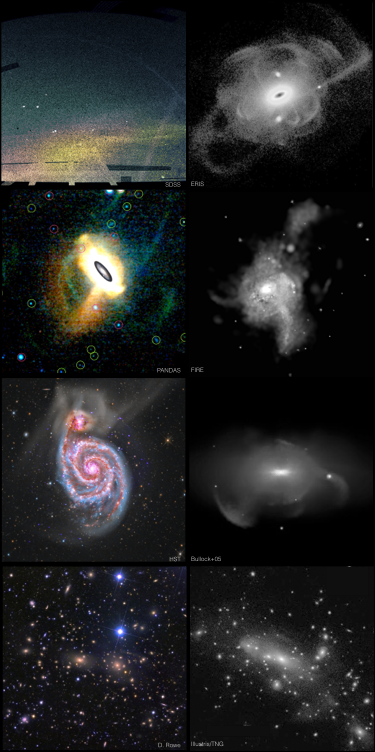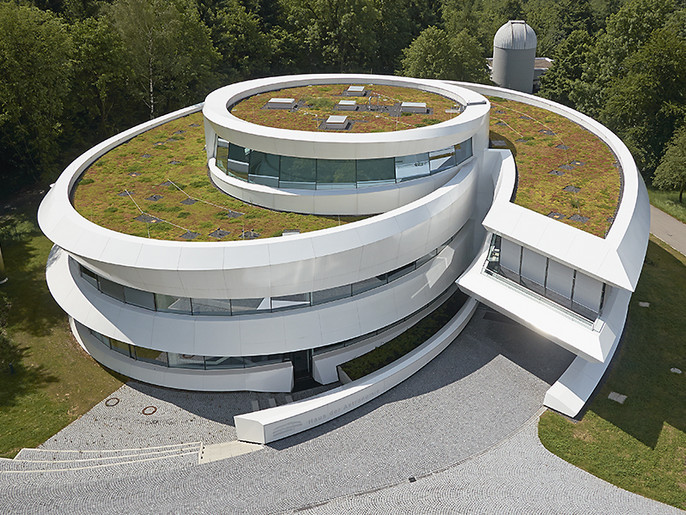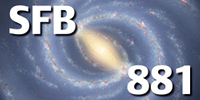Stellar halos across the cosmos
Connecting observations and simulations of stellar halos
over cosmic time, mass scales, and methodologies

Alexie Leauthaud
Annalisa Pillepich (Chair)
Annette Ferguson
Beth Willman
Carlos Frenk
Hans-Walter Rix
Kathryn Johnston
Masashi Chiba
Pieter van Dokkum
Rodrigo Ibata
Roelof S. de Jong
The prominent stellar bodies of galaxies are surrounded by extended, faint envelopes of stars, often called stellar halos or intra-cluster light. The Milky Way and Andromeda have played a special role in guiding our understanding of the structure and origin of stellar halos, and will continue to do so in the age of Gaia and spectral surveys. Furthermore, new windows are opening up on the low surface brightness components of extragalactic objects, both via resolved stellar-population studies as well as integrated-light imaging to ever deeper surface brightness limits.
In parallel, theoretical models (both ab initio hydrodynamical simulations as well as stellar-painting and controlled N-body numerical experiments) provide a foundation for interpreting these observations. They provide insight on the connection between stellar halos and intra-cluster stars to the hierarchical growth of structure in the LCDM cosmology.
This meeting aims to put together a comprehensive overview of our understanding or ignorance about galaxy stellar outskirts and stellar halos across all accessible galaxy mass scales, redshifts, and methodologies. By stellar halos we mean both structured and seemingly smooth distributions of stars beyond the central bright bodies of galaxies, and hence including streams, shells, satellite galaxies and intra-cluster light.
The advent of new data from ground-based and space telescopes over the next decade (e.g., Gaia, LSST, JWST, Euclid, GMT, TMT, E-ELT, WFIRST), with their resolved wide-field surveys, will provide the tools to put into effect the goals of "near-field cosmology”. Both observational and theoretical methods need to be refined and scaled up in order to process and extract the information content of the thousands of observed stellar halos that will become available in the near future.

Thanks to everyone who submitted abstracts!
Registration is now open for those who have submitted an abstract and have been included in the scientific program. Due to the capacity of the venue, registration is currently only available to participants with oral or poster contributions.
Note: Participants on the wait list will be contacted after May 2, and those with accepted abstracts at that point will have an extended registration deadline.
340 €
240 €
Chair: Eric Bell
Steve Majewski, Techniques for probing and surveys of the stellar halo of the Milky Way
Nicolas Martin, How to access the stellar halo of Andromeda
Denija Crnojevic, Resolved stellar populations beyond the Local Group
Bob Abraham, "Integrated light"
Magda Arnaboldi, Observations of the intra-cluster light
Chair: Sarah Loebman
Robyn Sanderson, Science with synthetic stellar surveys
Emily Cunningham, HALO7D: Disentangling the Milky Way's accretion history
Adrian Price-Whelan, A disk origin for inner stellar halo structures around the Milky Way
Marius Cautun, The MW-LMC Great Collision: MW's return to normality
Chair: Ana Bonaca
Jorge Penarrubia, "Idealized and analytical models"
Nicola Amorisco, Controlled and N-body experiments
Andrew Cooper, Particle tagging and semi-analytic models
Andrew Wetzel, Cosmological hydrodynamics simulations
Discussion
Chair: Hans-Walter Rix
Rodrigo Ibata, "Selected results with Gaia DR2"
Sarah Loebman, "Beta dips in the Gaia era"
Sarah Bird, Milky Way's anisotropy profile with LAMOST/SDSS and Gaia
Giuliano Iorio, A first Gaia look to the Galactic stellar halo
Khyati Malhan, Stellar stream map of the Milky Way Halo: Application of STREAMFINDER onto ESA/Gaia DR2
Chair: Raja GuhaThakurta
Karoline Gilbert, Progress and promise in deciphering the formation history of Andromeda's stellar halo
Christine Simpson, "Progenitors of the stellar halo in the Auriga simulations"
Thomas Guillaume, Tracing the stellar halo with BHB stars
Azi Fattahi, The origin of the inner stellar halo anisotropy
Nicolas Martin, The Pristine survey of the metal-poor halo
Nicola Amorisco, "Fuzzy dark matter, fuzzy GC streams"
Jorge Penarrubia, "The masses of the MW dwarfs"
GyuChul Myeong, Milky Way Halo in Action Space
Chair: Enrichetta Iodice
Antonela Monachesi, Comparing results from the GHOSTS survey and the Auriga simulations
Raúl Infante Sáinz, A crucial test in stellar halos physics: star counting versus integrated photometry techniques
Michael Rich, The Halos and Environments of Nearby Galaxies (HERON) project
Jenny Greene, "Low surface brightness galaxies with the Hyper Suprime-Camera Survey"
Denija Crnojevic, "Resolving the extended stellar halos of nearby galaxies: the wide-field PISCeS survey"
Javier Román, Pushing the low surface brightness limits: PSF and galactic cirrus characterization
In Sung Jang, Quantifying the faint outskirts of M101 using resolved stars
Alexie Leauthaud, Dark matter dictates the stellar envelopes of super massive galaxies
Carlos Frenk, "The imprint of cosmic reionization in the halo of the Milky Way"
Erik Tollerud, HI and stars in Local Group dwarfs: Is there a missing dIrr problem?
Jason Sanders, Tidal disruption of dwarf galaxies: The strange case of Crater II
Nicolas Garavito-Camargo, LMC vs MW: Effects on the stellar and dark matter halo of the MW
Jeff Carlin, Resolved stellar populations around Local Volume LMC stellar-mass galaxies
Adam Smercina, "The stellar halo and sparse satellite population of the 'Lonely Giant' M49"
Masahi Chiba, Structures of the MW luminous and dark halos revealed from Subaru/HSC survey
Behnam Javanmardi, Dwarf Galaxy Survey with Amateur Telescopes (DGSAT)
Chair: Alexie Leauthaud
Julien Lavalle, Alternative models of dark matter
Ling Zhu, "Dark matter fraction, internal rotation and velocity anisotropy from inner to outer halo"
Dennis Erkal, Gaps in tidal streams
Geraint Lewis, "The need for speed: Escape velocity and dynamical mass measurements of M31"
Ana Bonaca, What are the tidal streams constraining?
James Nightingale, Stellar halos with strong lensing
Discussion
Chair: Pierre-Alain Duc
Ana-Roxana Pop, Stellar shells in the Illustris simulation
Eduardo Balbinot, "The Milky Way halo as seen by the Dark Energy Survey"
Kris Youakim, "A large-scale clustering analysis of substructure in the Milky Way halo"
Lauren Anderson, "4D cold stream detection"
David Hendel, Automatic classificiation of tidal debris
Michael Gregg, Drilling through the M31 halo near Mayal-II/G1
Erin Kado-Fong, Tidal features in the HSC Subaru Strategic Program
Discussion
Chair: Michelle Collins
Annalisa Pillepich, Ex-situ vs In-situ stars: all you wanted to know about them... and from them!
Alina Boecker, Recovering the accretion history of galaxies from integrated spectra
Rhea-Silvia Remus, "Connecting in-situ and accreted populations to global stellar halo properties of galaxies"
Emma Fernández-Alvar, The characterization of the metal-rich stellar halo with Gaia DR2 and APOGEE
Richard D'Souza, Unravelling the Andromeda galaxy's most massive merger
Chervin Laporte, "Stellar disk streams as probes of the Galactic potential and satellite impacts"
Discussion
Chair: Ortwin Gerhard
Chris Mihos, Intra cluster light in the Virgo cluster
Lamiya Mowla, Dragonfly Wide Field Survey: Diffuse light in groups
Meng Gu, Hierarchical assembly of stellar envelopes in galaxy clusters
Enrichetta Iodice, Stellar halos and LSB features from deep VST surveys
Felipe Ardila, Stellar profiles of massive galaxies: Hyper Suprime-Cam survey vs hydrodynamic simulations
Claudia Pulsoni, The extended Planetary Nebula Spectrograph (ePN.S) early-type galaxy survey: The kinematic diversity of stellar halos and the relation between halo transition scale and stellar mass
Mireia Montes, Intracluster light: A luminous tracer for dark matter in clusters of galaxies
Discussion
Chair: Aaron Romanowsky
Dougal Mackey, "Halo-GC connection"
Jisu Kang, Globular cluster systems in the giant halo of the Sombrero galaxy
Joel Pfeffer, E-MOSAICS: tracing galaxy formation and assembly with globular clusters
Meghan Hughes, "Galactic tidal features and their star cluster populations with E-MOSAICS"
Christopher Usher, Exploring galaxy formation histories with globular cluster stellar populations
Asher Wasserman, Globular clusters as tracers of stellar and dark halos
Raja GuhaThakurta, Stellar halos in three environments
Discussion
Chair: Richard D'Souza
Eric Bell, What do mergers do to galaxies?
Rodrigo Cañas, Diffuse stellar halos in state-of-the-art cosmological hydrodynamical simulations
Aaron Romanowsky, "Chemo-dynamics and substructure in galaxy halos beyond the Local Group"
Prashin Jethwa, Merger histories from integrals of motion in external galaxies
Felix Schulze, "Connecting outer stellar halo kinematics to the formation histories of early-type galaxies"
Daniel Thomas, Stellar populations in galaxy haloes with SDSS-IV/MaNGA
Discussion
Chair: Karoline Gilbert
Pieter van Dokkum, "Ultra diffuse galaxies with Dragonfly"
Andrew Wetzel, "The origin of ultra diffuse galaxies"
Michelle Collins, "Tidal interactions as a means of forming ultra diffuse galaxies"
Elisa Toloba, "Internal dynamics and dark matter halos of ultra diffuse galaxies"
Sungsoon Lim, Globular cluster populations in Coma ultra diffuse galaxies
Discussion
David Martinez Delgado, "Hidden depths: A search for stellar tidal streams in the Local Universe with deep imaging"
Chair: Elisa Toloba
Pierre-Alain Duc, Outer 'normal' halos in integrated light
Kevin McKinnon, The ubiquity of stellar halos in the Virgo Cluster
Aaron Emery Watkins, The stellar and gaseous halo of M51
Allison Merritt, Observing stellar halos in IllustrisTNG
Magda Arnaboldi, "Newly discovered planetary nebulae population in the outer disk and halo of M31"
Discussion
Colin Slater, Stellar halos with LSST
Nushkia Chamba, Stellar halos build-up as revealed by ultra-deep imaging
Moritz Fischer, "A multi-dimensional atlas of in-situ vs ex-situ stars from IllustrisTNG galaxies"
Colleen Gilhuly, "The Dragonfly Edge-on Galaxies Survey"
Johanna Hartke (in absentia), "Tracing the build-up of M49's extended halo and surrounding intra-group light with stellar kinematics"
Myung Gyoon Lee, "Resolved stellar populations in stellar halos and formation of massive galaxies"
R. Michael Rich, "The Halos and Environments of Nearby Galaxies Survey: New results on boxy bulges and two nearby galaxies with extended UV and HI emission"
Patrick Ondratschek, "Systematic uncertainties in the measures of the stellar halo density profiles"
Max Sasserath, "The mass assembly of massive galaxies and their ICL"
Lisa-Marie Zessner, "Inputs from IllustrisTNG stellar halos on the relation between metallicity gradients and assembly history"
The conference will be split into several components, with the primary goal being to make the meeting as interactive as possible. These include review talks; general sessions featuring invited talks, contributed talks (12 min), as well as shorter flash talks (4 min); moderated "un-conference" sessions amongst subsets of attendees; and extended breaks to facilitate continued discussions in a less formal setting.
Please make sure to check that your passport is up-to-date before finalizing your travel arrangements!
Depending on where you live, you may or may not need to apply for a visa
to enter Germany.
For information by country, please see this overview of
visa requirements.
We recommend that you fly into Frankfurt Airport (FRA), as this is the nearest international airport to Heidelberg. The following directions to Heidelberg assume that you are starting from Frankfurt; if you choose to use a different airport and would like assistance organizing travel to the conference please contact the LOC.
We recommend that you figure out transportation to Heidelberg in advance! There are several options from Frankfurt Airport:
Deutsche Bahn (DB) will take you directly from Frankfurt Airport (station: Frankfurt(M) Flugh.) to various train stations around Heidelberg (likely either Hauptbanhof or Altstadt, depending on where your hotel is). Not all trains travel at the same speed, but you can expect travel times somewhere in the range of 60-90 minutes.
The trip will be about 25 € each way, and you can download the DB Navigator app to check time tables and buy tickets in advance. Note that these can be bought fairly last-minute, though, so we recommend waiting until you know whether or not your flight will be on time before purchasing.
For a cheaper but slightly less efficient alternative, you can take Flixbus from the airport to Heidelberg. Prices typically range from 5-15 € each way, but depending on the time of day the trip could take up to 3 hours due to traffic. To investigate time tables and book tickets, you can check out the Flixbus website or app.
The two best shuttle options are Transfer & Limousine Service (TLS) (40 € each way) and Lufthansa Express Shuttle (25 € each way).
There is no official Frankfurt-Heidelberg group shuttle for the conference; however, if you are interested in coordinating trains, buses, shuttles or etc with anyone we encourage you to fill out your name and travel plans in this google sheet and plan amongst yourselves!
Finally, if you decide to rent a car and drive, you can follow these directions.
There will be two shuttles that will transport everyone up the hill to MPIA/HdA every morning from behind the Crowne Plaza Hotel on Bahnhofstrasse at 8:20am and from Peterskirche (the side of the road closest to the hill!) at 8:30am.
NOTE: The first day of the conference, the pickup times will be 8:00am and 8:10am, respectively, to account for an early start to the day (for on-site registration).
A member of the LOC (TBD) will be waiting near the bus stop 15 minutes before the scheduled departure with a sign for the conference every morning; look for them to make sure you have the right bus!
In the evening, the two buses will leave from the conference venue 15 minutes after the end of the last session. You can download a PDF of the conference bus schedule here.
At other times of the day, you can take Bus 30, aka the "Science Bus" up to MPIA (the bus will drop you off right outside HdA) or back down the hill (likely get off at Peterskirche, depending on where your hotel is). You can buy tickets online or via ticket machines (the cost is approximately 2.50 € per day).
The easiest way to explore Heidelberg is on foot! We suggest downloading an offline map of the area before you arrive, although there are a few spots around the city (e.g. Universitätsplatz or Bismarckplatz) where you can find free wifi.
Public transportation in Heidelberg is provided by the Rhein-Neckar-Verkehr (RNV) in the form of buses and trams; these can take you more or less anywhere you want to go within the city and are on time more often than not. The timetables can be found online; you can also download various apps to help you plan, e.g. the official RNV app (in german) or the VRN Ticket app (in english); or just use google maps.
Heidelberg has plenty of hotel and airbnb options; the following hotels currently have blocks of rooms reserved for this conference at a reduced price.
Note: If you are interested in sharing a room with other participants, please notify us of this when you register — we will not be assigning rooms, but we will provide a spreadsheet with contact information to facilitate coordinating reservations.
Use booking code: MPIA
Note: With the exception of Mille Stelle Hotel Heidelberg GmbH, breakfast is included in the quoted prices. Additionally, for Mille Stelle Hotel Heidelberg GmbH, a cancelation fee of 80% of the cost of the room applies (for cancelations less than 2 weeks in advance).
We will have a conference dinner on Thursday, July 5th. The dinner and reception will be held at Palais Prinz Carl, with the reception starting at 7pm and dinner starting at 7:30pm. Weather permitting, the reception will be held outdoors in the adjacent courtyard (Kornmarkt).
Please design your posters to conform to A0 standards. Poster boards and pins will be provided!
The conference will be held at the Haus der Astronomie (HdA) at MPIA in Heidelberg. HdA (pictured to the right) is the Center for Astronomy Education and Outreach in Heidelberg; more information about the center and its facilities and resources can be found here.
Note: Cell reception at MPIA is very poor, although there will be sufficient WiFi connectivity. Please plan accordingly.
We will continuously update the website with talk slides.
Talks can be streamed to two of the seminar rooms in HdA.
HdA itself is accessible, and handicap parking is available. Unfortunately, the conference shuttles are not accessible; however, there are taxi services in Heidelberg that are. ASL services can also be provided on request (please do this when you register). If you have any questions please feel free to contact either the LOC or Ralf Launhardt (MPIA's Representative for Disabled Persons).

Stellar Halos Across the Cosmos is partially sponsored by the Sonderforschungsbereich (SFB) 881.
